Beer-Making Yeast Could Also Be Used To Ferment Chocolate, Making It Taste Better

It turns out microbes, the oldest form of life on earth, are key to a good chocolate. In fact, a new study from Belgian researchers finds the very same species of yeast used to make bread, beer, and wine works particularly well in chocolate fermentation.
Microbial fermentation is a crucial step in the production of beer, cheese, wine, and chocolate. In each case, quality of the final food or beverage product depends on the microbes present during fermentation, with even slight deviations in the microbial population yielding marked differences. Though for thousands of years fermentation was conducted spontaneously, since the 19th century, many industries adopted the use of starter cultures, which increase the reproducibility and efficiency of the fermentation process, ultimately resulting in a more consistent product.
The cocoa industry, though, is a notable exception. To this day, chocolate production relies on whatever highly variable microbial population exists at any given cocoa farm. Many cocoa farmers intentionally expose their beans to the natural environment, placing them in open wooden boxes, and, in some cases, piling them on the soil. Here, the beans become surrounded by an unappetizing gooey pulp composed of sugars, proteins, water, pectin, and small amounts of lignin and hemicellulose (types of organic polymers), explained Dr. Kevin Verstrepen, lead researcher and a professor of genetics and genomics at University of Leuven and Flanders Institute for Biotechnology. At this stage microbes go to work consuming the pulp, a process known as fermentation.
Different microbes create different flavors in the resulting chocolate, so each farm creates a unique flavor and quality profile based on its individual microbial population.
"Some microbes produce bad aromas that enter into the beans, giving rise to chocolate with a foul taste, while others do not fully consume the pulp, making the resulting beans difficult to process," Verstrepen stated in a press release.
So he and his team searched for the best microbes, ones that could outcompete less desirable microbes and result in a higher quality chocolate. In essence, he wanted to create a starter culture and that was easier said than done.
Hybrids
To begin, Verstrepen and his colleagues characterized more than 1,000 strains of Saccharomyces cerevisiae, mostly from the alcoholic beverage industry. Next, the investigators crossed some of the best performers — just as you would cross-breed animals — to produce even better performing hybrids. Yet, compared to crossing sheep, Verstrepen explained, crossing yeasts is more challenging, requiring highly accurate microscopy and generally more finesse.
Next, the science team applied their new hybrids to fermenting chocolate and yielded unique chocolate flavors from each strain of yeast. At last, the moment of truth: the research team’s industrial partner, Barry-Callebaut, made chocolates based on each strain for a private taste-testing.
What were the results? Unanimously, the panel voted in favor of the chocolates derived from the newly developed fermenting process. Going forward, Barry-Callebaut plans commercial production of a range of tailor-made chocolates, using some of the novel yeasts. According to Verstrepen, it should be "possible to create a whole range of specialty chocolates to match everyone's favorite flavor."
Source: Meersman E, Steensels J, Paulus T, et al. Application of a breeding strategy to generate robust yeast starter cultures for cocoa pulp fermentations. Applied and Environmental Microbiology. 2015.



























